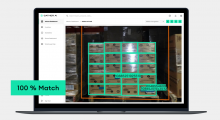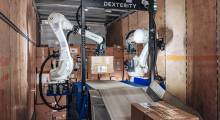E-commerce is changing the dynamics of retail: To compete with the instant gratification of brick-and-mortar retail, e-commerce sites are pushing the envelope on order cycle times to get product into the hands of customers faster than ever.
That push is also changing the economics of automation in e-commerce order fulfillment and distribution. Where automation was once only viable when sales reached a certain dollar and volume threshold, even smaller pure play e-commerce retailers are embracing high levels of automation to get orders out the door—and creating a new market for the industry.
This was the case at BHFO.com, a fast-growing 12-year-old e-commerce site based in Cedar Rapids, Iowa, with about $30 million in annual sales. BHFO features top designer brands of clothing, shoes and accessories at bargain prices on its Web site—the FO stands for factory outlet.
The retailer ships around the globe from its 250,000-square-foot headquarters, which includes 200,000 square feet of warehouse space. With double-digit growth, BHFO’s biggest challenge in recent years was getting orders out the door fast enough to meet customer service expectations. That’s where automation came into play. Working with a systems integrator (Bastian Solutions, bastiansolutions.com), BHFO implemented a goods-to-person order fulfillment and picking solution (OPEX, opex.com) that uses mobile robots to store and retrieve items about to be picked in a compact, high-density storage system that takes full advantage of the building’s 36-foot ceilings. The totes are then delivered to light-directed, goods-to-person picking stations.
The system has four putaway and picking lanes, and each lane is serviced by five mobile robots inside the storage area. In all, the system can hold 163,000 items at a time and process nearly 2,000 orders a day in roughly 20,000 square feet of space. And, in keeping with its cutting edge approach, BHFO is using iPods instead of conventional mobile computers on the warehouse floor.
Since going live in March 2014, COO Matt Wade says the site has seen accuracy rates rise to the high 90th percentile and a 30% decrease in the staff dedicated to fulfillment in its former manual system. More importantly, BHFO has seen a significant improvement in its cycle times and order fulfillment rates. “Prior to automating, most domestic orders shipped within two business days from the time of payment,” says Wade. “Now, we’re getting 95% of our domestic orders shipped within one day of payment.”
Explosive growth
You probably don’t think of Cedar Rapids as a hot bed of retail innovation, but that’s where Jon and Stacie Sefton launched BHFO from their basement back in 2003. The B and H are the initials of their daughters.
From day one, the company focused on selling high-end clothing at factory outlet prices, beginning with a partnership to help a well-known lingerie company liquidate its shelf pulls and returns. The site was hosted on eBay, where items were sold through an auction model. Eighteen months later, the company had outgrown the basement and moved into a commercial warehouse.
Since then, BHFO has continued to add brands, product sources and employees to fuel significant growth—the target for 2015 is 50% growth in sales to $45 million, Wade says. “We are expanding our vendor partnerships and try to bring 6,000 new products to the marketplace on a daily basis,” Wade adds.
In addition to the auction site on eBay, BHFO is now working to expand its catalog to Amazon customers. BHFO is also available on Australia’s TradeMe and the company is in negotiations to go live on MercardoLibre, an online marketplace serving South America.
After leaving the basement, there were several moves, including 100,000 square feet of distribution space spread across two buildings. By 2013, even that was not enough; BHFO was relying on commercial warehousing to prepare and stage pallets for processing before they were transferred to the main space. “We were inefficient because of the manual picking and handling and had the added expense of outside warehousing and transportation,” Wade says. What’s more, it took two days to process most orders.
“In e-commerce, you have to get domestic orders out within one day of payment if you want to be competitive and keep your customers happy,” Wade says. “Knowing the markeplace and how we wanted to grow, Jon and Stacie believed we had to automate to grow.”
Goods-to-person system
The search for an automated solution began in 2012. The goal was to implement a goods-to-person system to cut down on travel time in the warehouse and rev up cycle times. BHFO initially looked at a number of automated systems, including mobile robots. The company was analyzing the return on investment of one solution in particular when Jon Sefton learned about an alternative solution at a business conference.
That led to discussions with a systems integrator about alternatives, including horizontal carousels. Ultimately, they chose the solution in place for several reasons. For starters, by using the whole cube of the building, the order fulfillment system occupies 20,000 square feet of the 200,000-square-foot warehouse. That leaves plenty of room for processing as well as handling space for apparel that needs to be hung rather than folded and placed into a tote.
“The ceilings in our new facility are 36 feet tall, and this solution would allow us to take advantage of the cube of the building,” Wade says. “Once we saw it in operation, and analyzed how it would work with our operation, we knew it was a good fit.”
As designed, the system has four 80-foot lanes and four pick stations—one on each lane. Depending on order volume, picking can be handled by four operators, or two operators picking from two lanes at once. Inside the high-density storage and sequencing system, five mobile robots manage putaway and retrieval in each lane. The system was originally designed to handle 150,000 items but has since been expanded to 163,000 items to accommodate the growth in categories and SKUs. Since the system is modular, it can be expanded in the future to handle BHFO’s growth. Or, alternatively, BHFO could add more units if needed.
Picking at the goods-to-person workstations is designed to ensure order accuracy. A touchscreen displays a picture and the lot ID of the item to be picked. Pick-to-light identifies the right order tote on the conveyor as well as the right storage cell in the storage totes. Finally, order selectors scan each item to verify the pick. “The system won’t let us pick the wrong item,” says Wade.
The design of a new corporate headquarters and the implementation of an automated picking system coincided with the implementation of a new retail enterprise resource planning (ERP) system, including order and warehouse management to drive more efficiency.
Operations are relatively straight forward. With a 90% average sell-through rate, the facility is designed to process newly received products for sale online and then move through the building quickly and efficiently. Storage is at a minimum: In the receiving area, new merchandise is staged, processed to be displayed online and then bagged and labeled for shipping.
From there, product is inducted into the order fulfillment system; items that are too big to be handled by the mobile robots are hung on piping in the warehouse space or stored on shelving. The exception is a growing category of fixed-price items that are stored in pallet rack. Because those items are not sold in the auction model, they may remain in the facility for a longer time period.
Order picking and packing of the previous day’s orders begins each morning. That way, the bulk of domestic orders are shipped within one day of confirmation of payment.
According to Wade, the system went live in March of 2014 and included two months of testing. After nearly a year working with the system, BHFO has seen accuracy consistently in the high 90th percentile; cycle times have improved; and the number of associates dedicated to fulfillment has decreased by 30%. Those associates have moved into other areas of the operation, including sales and customer service.
More importantly, BHFO’s fulfillment operations can accommodate the company’s continued growth and drive for customer satisfaction. “It’s easy to scale the system: We can make rows longer, add rows, add pick stations or add more mobile robots,” he says. “What’s more, in the online world a happy customer is a repeat customer. Getting orders out the door more quickly is driving customer satisfaction.”
Mobile robots and goods-to-person picking power order fulfillment at BHFO
The compact system processes nearly 2,000 orders a day in 20,000 square feet.
System Suppliers
System integrator, warehouse control system and conveyor: Bastian Solutions, bastiansolutions.com
Goods-to-person fulfillment system: OPEX Corp., opex.com
Warehouse management system: RetailOps, retailops.com
Mobile computing: Apple (iPods), apple.com
Bar code scanning: Infinite Peripherals, ipcprint.com
Bar code software: Seagull Scientific, seagullscientific.com
Lift trucks: Crown Equipment Corp., crown.com; Toyota Industrial Equipment, toyotaforklift.com
Auto bagging equipment: Sharp Packaging Systems, sharppackaging.com
About the Author
Follow Robotics 24/7 on Linkedin
About the Author
Follow Robotics 24/7 on Linkedin
Article topics
Email Sign Up















